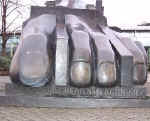Edinburgh & Glasgow Local Monuments |
| 1) The Call |
Opposite St, Mary’s Cathedral, Edinburgh
Typology -Urban renewal and commemorative, a “ social sculpture”, also site Specific in that column fragments echo the monument on Carlton hill, As well as the grandeur of the Roman Catholic Church they sit before.
Construction / Completion Dates -
Cast by the Rainund Kitti foundry, Dusseldorf. Installed in July 1991
Description -
Abstracted figurative public artwork, comprising of 3 separate large-scale bronze sections with low -relief inscriptions –
MS. OF MONTE CASSINO
Ad Paulum diaconum
Hinc celer egrediens facili, mea carta, volatu
Per silvas, colles,valles quoque prepete cursu
Alma deo cari Benedicti tecta require.
Est nam certa quies fessis venientibus illuc,
Hic olus hospitibus, piscis hic, panis abundans;
Pax pia, mens humilis, pulcra et Concordia fratrum,
Laus amor et cultus Christi simul omnibus horis.
This translated MS OF MONTE ASSINO
Written to Paul the Deacon at monte cassino
Across the hills and in the valley’s shade, along the small script goes,
Seeking for benedict’s beloved roof,
Where waits it’s sure repose.
They come and find, the tired travellers,
Green herbs and ample bread,
Quiet and brother’s love and humbleness,
Christ’s peace on every head.
The entire text in Latin is inscribed round the ankle and foot. Professor Duncan Macmillan wrote on the work ‘ near his birth place in Leith walk, there is the Manuscript of Monte Cassino, an extraordinary soliloquy on the whole of the theme of the humanist civilisation that derives from the classical tradition, its mighty past, its present ruined state, its doubtful failure.’
Artist -
Eduardo Paolozzi, the Queens Sculptor-in-Ordinary for Scotland, a Sculptor of National and international importance, highly prolific since the mid twentieth century. A core artist of the POP ART movement.
Urban – Rural Context -
Urban city centre public thoroughfare; retail, tourist, entertainment and religious district.
Rationale –
Links with Italian immigrants to Scotland and homage to Paolozzi’s Italian roots. Social sculpture created in a ‘safe haven’ for an interactive public. Perhaps the hand, ankle and foot also represent the journey that he made and how he was welcomed so warmly into a foreign country?
